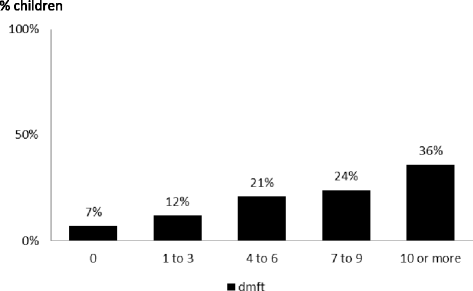An assessment of the impacts of child oral health in Indonesia and associations with self-esteem, school performance and perceived employability
- PMID: 28327110
- PMCID: PMC5361816
- DOI: 10.1186/s12903-017-0358-5
An assessment of the impacts of child oral health in Indonesia and associations with self-esteem, school performance and perceived employability
Abstract
Background: Previous surveys have indicated that a majority of Indonesian children have poor oral health. However, little detailed information is available on underlying causation and none that examine impacts of oral health on child self-esteem, school performance and perceived employability. The aim of this study was to determine levels of child oral health in primary school children in Indonesia, the prevalence of key causal factors; and, to determine relationships between oral health, self-esteem and school academic performance.
Methods: Cross-sectional epidemiological study in a sample (n = 984) of children aged 6-7 and 10-11 years old attending three public schools in Indonesia. A dental visual impact study was conducted, in which teachers reported their perceptions of the impact of child oral health on school academic performance. Oral health behaviors, self-esteem, and school performance were assessed. The children were clinically examined to measure dental caries and oral cleanliness.
Results: Teachers believe that children with visually poor oral health and impaired smiles are more likely to perform poorly at school, be socially excluded and have lower job prospects than their peers with visually good oral health and healthy smiles. The percentages of children with decayed teeth were 94 and 90% in the 6-7- and 10-11-year age groups, respectively. Families reported high levels of child consumption of sugar-containing foods and drinks; many had irregular use of fluoride toothpaste. Children with substantial plaque on their teeth achieved significantly lower levels of school performance than their peers with clean teeth. Significant associations were found between school performance and self-esteem for these children.
Conclusions: The study findings highlight the need for preventive care programs to improve the oral health of children in Indonesia and prospective determination of associations between child oral health; self-esteem and school academic performance.
Keywords: Caries; Children; Indonesia; Oral health; Self-esteem.
Figures
Comment in
-
Is there evidence for the impact of poor oral health on school performance?BMC Oral Health. 2019 Jul 11;19(1):143. doi: 10.1186/s12903-019-0822-5. BMC Oral Health. 2019. PMID: 31296203 Free PMC article.
References
-
- Maharani DA. Perceived need for and utilization of dental care in Indonesia in 2006 and 2007: a secondary analysis. J Oral Sci. 2009;218(3):229–239. - PubMed
-
- Bali Declaration (2013) Good Oral Health as Investment in Children’s Future The 7th Asian Conference of Oral Health Promotion for School Children (ACOHPSC), September 12–14, 2013, Bali, Indonesia
MeSH terms
LinkOut - more resources
Full Text Sources
Other Literature Sources
Medical


